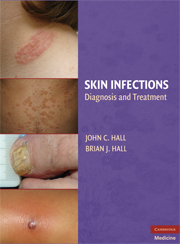Book contents
- Frontmatter
- Contents
- List of Contributors
- Acknowledgments
- INTRODUCTION
- TECHNIQUES IN DIAGNOSING DERMATOLOGIC MANIFESTATIONS OF INFECTIOUS DISEASES
- PRINCIPLES OF MANAGEMENT OF DERMATOLOGIC INFECTIONS IN THE SKIN
- PART 1 COMMON INFECTIONS
- PART II LESS COMMON INFECTIONS
- PART III INFECTIONS IN SELECTED ECOSYSTEMS
- PART IV INFECTIONS IN SELECTED PATIENT POPULATIONS
- PART V INFECTIONS OF SPECIFIC SKIN-ASSOCIATED BODY SITES
- PART VI SPECIAL DISEASE CATEGORIES
- 23 INFECTIONS IN SKIN SURGERY
- 24 VENEREAL DISEASES
- 25 LIFE-THREATENING SKIN INFECTIONS: SKIN SIGNS OF IMPORTANT BACTERIAL INFECTIOUS DISEASES
- Index
24 - VENEREAL DISEASES
from PART VI - SPECIAL DISEASE CATEGORIES
Published online by Cambridge University Press: 08 January 2010
- Frontmatter
- Contents
- List of Contributors
- Acknowledgments
- INTRODUCTION
- TECHNIQUES IN DIAGNOSING DERMATOLOGIC MANIFESTATIONS OF INFECTIOUS DISEASES
- PRINCIPLES OF MANAGEMENT OF DERMATOLOGIC INFECTIONS IN THE SKIN
- PART 1 COMMON INFECTIONS
- PART II LESS COMMON INFECTIONS
- PART III INFECTIONS IN SELECTED ECOSYSTEMS
- PART IV INFECTIONS IN SELECTED PATIENT POPULATIONS
- PART V INFECTIONS OF SPECIFIC SKIN-ASSOCIATED BODY SITES
- PART VI SPECIAL DISEASE CATEGORIES
- 23 INFECTIONS IN SKIN SURGERY
- 24 VENEREAL DISEASES
- 25 LIFE-THREATENING SKIN INFECTIONS: SKIN SIGNS OF IMPORTANT BACTERIAL INFECTIOUS DISEASES
- Index
Summary
INTRODUCTION
Because many of the most common sexually transmitted diseases (STDs) present with prominent and characteristic skin lesions, dermatologists have historically played a key role in their diagnosis and treatment. Dermatologists continue to contribute in both diagnostic and therapeutic endeavors, often working closely with gynecologists, urologists, infectious disease specialists, and family physicians, and others. Despite improved public awareness and continued diagnostic and therapeutic advances, STDs remain a major source of morbidity and mortality throughout the world. The urgency with which the health-care profession addresses STDs will intensify along with a better understanding of the full impact they have on public health. It has recently become apparent, for example, that the genital ulcers associated with many of the common STDs facilitate the transmission of the human immunodeficiency virus (HIV) and that some STDs (notably herpes progenitalis) may adversely affect the course of HIV infection. Moreover, recent Centers for Disease Control and Prevention (CDC) estimates place the direct health-care costs for STDs at well over $13 billion annually in the United States alone (http://www.cdc.gov/std/stats04/trends2004.htm, accessed May, 2007). The long-and short-term physical and mental health consequences of STDs are indeed extensive, and it is critical that health-care providers remain apprised of current trends in epidemiology, diagnosis, and management of these diseases. The present chapter focuses on the cutaneous manifestations and current diagnostic and therapeutic recommendations for STDs including syphilis, chancroid, lymphogranuloma venereum, granuloma inguinale, gonorrhea, and genital bite wounds. Scabies, pubic lice, genital herpes, and anogenital warts are covered in more detail elsewhere in this book.
- Type
- Chapter
- Information
- Skin InfectionsDiagnosis and Treatment, pp. 309 - 321Publisher: Cambridge University PressPrint publication year: 2009



